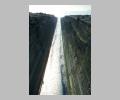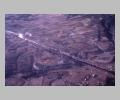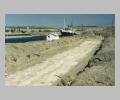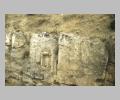Corinthia
Physical Description
Corinthia is the northeastern portion of the Peloponnese. Corinthia controls the Isthmus, the narrow rock that connects the Peloponnese to the mainland, allowing it to control communications between the Corinthian and the Saronic Gulfs, and between north Greece and the rest of the Peloponnese.
The Isthmus of Corinth is a low, flat tract of limestone, less than 90m at its highest point, barely 6 km wide at the narrowest point. All overland connections between northern and southern Greece are naturally drawn into this bottleneck at the Isthmus, where the passage is narrowed by the mass of Mount Gerania. Because of its position and the surrounding topography, Corinth, the main city, commanded all the land entries into the Peloponnese, and provided the shortest haulage for ships and cargo from gulf to gulf. This difficult process was facilitated, in antiquity, by the laying of rollers between the two points. Now, of course, the isthmus is cut by the Corinth canal, which was constructed between 1882 and 1893. The present canal follows the same line as a canal planned but never excavated by the Emperor Nero.
Even without the modern luxury of the canal, Corinth was still in a unique position for trade by both sea and land. Access to both gulfs through the ports of Lechaion, on the Gulf of Corinth, and Kenchreai, on the Saronic Gulf, and its control of the Isthmus gave the region much power. Archaic period pottery made in Corinth was exported more widely than that of any other Greek city. The plain of Corinth with the city at its center was a source of potter's clay, and its fertile soil produced good wines in addition to grain. In Medieval and modern times Corinth was the most important producer of currant grapes in Europe. Kenchreai served as the port of Corinth in ancient times. Today many of the original harbor works lie under water, including a temple from the Classical period.
History
By Classical times, Corinth was the major city of Corinthia and it controlled all trade and communications across the Isthmus. The vicinity of Corinth has been occupied since Neolithic times. Corinth's strategic position secured its greatness in history. The city reached its zenith in the classical period when it rivaled Athens as a commercial center, a sponsor of the arts, particularly fine pottery and bronzes, and as a founder of great colonies, most notable in Sicily and southern Italy. Corinth was of major political importance in classical antiquity,and was often an ally of the Spartans. The Roman general Mummius sacked the city in 146 B.C., the same year that Carthage was destroyed, and put an end to Greek autonomous city life. Re-founded as a colony in 44 B.C. by Julius Caesar for his veterans of the Gallic campaigns, Corinth was once again a prominent city in Roman times. The city was a center used to control the Peloponnese successively by the Byzantines, the Franks, the Venetians, and the Turks, and today is again an important commercial city.
Sites
The ancient city of Corinth lay below the great rock of of Acrocorinth ( 575 m), which provided the city with an almost impregnable citadel. In addition to being a center of commercial activity, Corinth was also known for the Isthmian games which were held in the vicinity every other year. After the present city of Corinth was transferred to a new site in 1858 after a severe earthquake, the extensive remains of the ancient city have been uncovered by archaeologists from the American School of Classical Studies.
In addition to Corinth, the region of Corinthia contained other important cities and sanctuaries. Isthmia, a city located to the southeast of Corinth, was the site of the sanctuary of Poseidon, one of four celebrated Panhellenic sanctuaries in Greece. All were renowned for the games. Like those at Delphi, Nemea, and Olympia, the games at Isthmia, established in 582 B.C., were originally established to honor a dead hero.
About 0.6 km south of the sanctuary of Poseidon stood the city of Kenchreai, the ancient Corinthian port. In the opposite direction, to the north of Corinth, sitting at the end of a narrow peninsula that separates the Halcyonic Gulf from the Gulf of Corinth is the ancient shrine of Hera at Perachora. The Heraion was founded in the Geometric period under Argive influence, but it really flourished under Corinthian leadership in the Archaic and Classical periods. On the shores of the bay stands an altar dated to about 500 B.C., decorated with Doric triglyphs. To the north was the temple of Hera Akraia and adjacent to the temple was an L-shaped stoa of the fourth century B.C. Nothing is known of the cult practices of the Geometric period, only that there was an oracle to Hera. In the fourth century B.C. the sanctuary was seized and abandoned.
To the northwest of Corinth sat the small coastal city of Sikyon, the home of the fourth century sculptor Lysippos. The ancient town contained a theater, a stadion, a gymnasium, a bouleuterion, a temple and an agora.
Curtis Runnels

east half of canal from west
|

aerial view of central section of canal from southeast
|

east end from northwest
|

aerial view of east half from east
|

paved slipway on south side of canal from west
|

overall view of slipway on north side of canal from northeast
|

detail of ruts in paved slipway on north side of canal
|

relief carving at west end of canal
|

vineyards on coastal plain
|

view west from Acrocorinth to Mount Kyllini
|